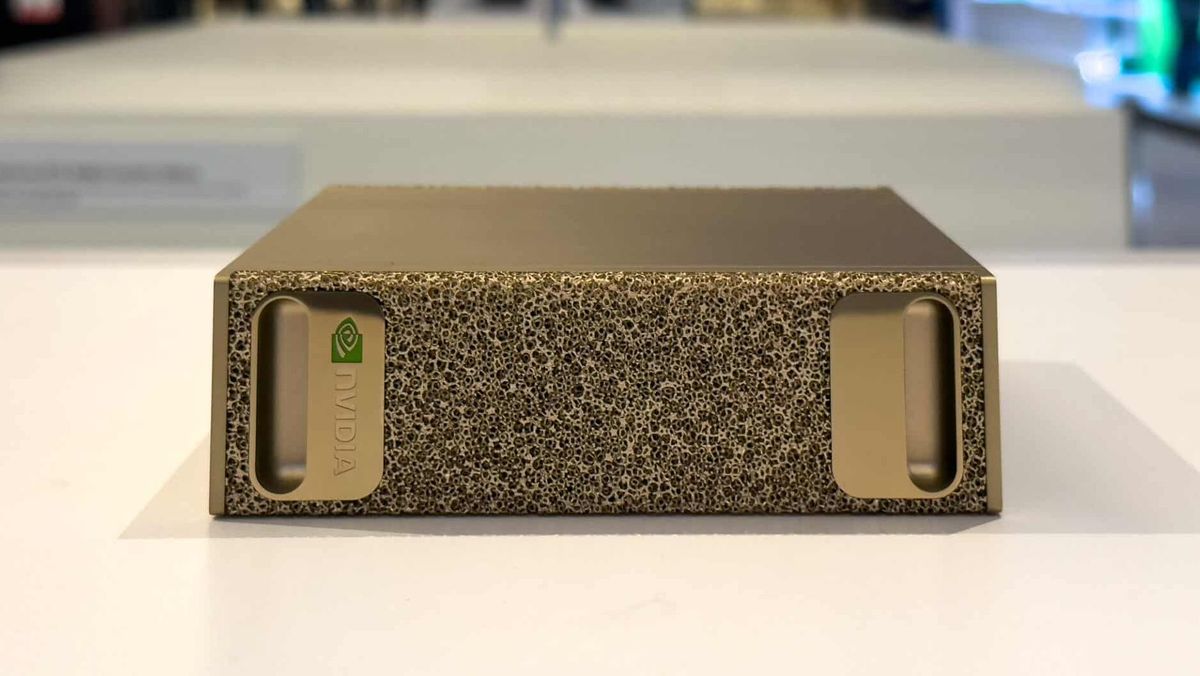Unique Features of NVIDIA® Project DIGITS
- Easy to use: DIGITS offers an intuitive user interface, allowing users to manage deep learning training jobs with ease.
- Distributed Training: The software provides features for large-scale distributed training, allowing to train models across multiple GPUs.
- Visual Progress: It allows users to visually monitor the progress of the training process in real-time.
- Diverse model architecture: DIGITS support various neural network architectures, including AlexNet, GoogleNet, and LeNet.
Advantages of NVIDIA® Project DIGITS
- Preprocessing: NVIDIA DIGITS provides built in features to preprocess data before inputting it into the model, saving users significant processing time.
- Improved Accuracy: DIGITS offers hyper-parameter optimization features that can help achieve top-notch accuracy.
- Quick Prototyping: The platform allows for fast model deployment, enabling quick prototyping and shortening the experimentation cycle.
- Compatibility: DIGITS is compatible with popular deep learning frameworks like TensorFlow, Caffe, Torch, and Theano.
- Workflow Integration: NVIDIA DIGITS allows for easy integration with existing data science workflows, including integration with Jupyter notebooks.
Limitations in the Interface
- The user interface of NVIDIA® Project DIGITS is not particularly intuitive or user-friendly. It is quite complex and can be confusing for beginners or those not well-versed in deep learning techniques.
- There are also minimal options for customization in the interface, limiting the user’s abilities to modify the setup to their own needs.
- The design is also somewhat outdated, which may not appeal to users who are accustomed to modern, sleek software aesthetics.
Dependent on NVIDIA® Hardware
- One of the biggest downsides to NVIDIA® Project DIGITS is that it is completely dependent on NVIDIA® hardware. If you do not have an NVIDIA® GPU, you simply cannot use the software.
- This leaves a considerable number of potential users out of the loop, specifically those who may not have the resources to invest in expensive hardware.
- Given the rapid evolution of GPU technologies, a user also runs the risk of having to make frequent upgrades to stay compatible with the software’s requirements.
Problems with Documentation
- Although NVIDIA® generally does a decent job of offering comprehensive documentation for their products, there has been feedback suggesting that the documentation for Project DIGITS could be improved.
- It lacks detailed step-by-step guides necessary for less tech-savvy users to get started. The explanations used are often too technical for beginners to understand.
Limited Scalability
- NVIDIA® Project DIGITS is primarily designed for single workstation jobs. The software lacks the ability to operate over a scalable distributed system.
- This means that for large-scale jobs that need to be distributed across multiple machines, Project DIGITS is unlikely to be the optimal solution.
Lack of Flexibility
- Despite its strengths, NVIDIA® Project DIGITS lacks flexibility in a number of areas. It doesn’t support a range of other popular deep learning frameworks.
- The software also lacks an API, limiting its potential to be integrated with other software or platforms.
NVIDIA® Project DIGITS Versus TensorFlow™
| Metric/Feature | NVIDIA® Project DIGITS | TensorFlow™ |
|---|---|---|
| Size | Depends on user-imported models | Varies according to the model complexity |
| Cool Factor | Easy-to-use graphical interface | Widely recognized and used open-source library |
| Price | Free with NVIDIA hardware | Free open-source |
| Performance | Optimized for GPUs, potentially faster for large datasets | Flexible, works on multiple hardware types, but may not be as fast for large datasets |
| Engineering Design | Designed specifically for deep learning on NVIDIA GPUs | General-purpose machine learning framework designed for scalability and flexibility |
| Quality | Simplifies deep learning, but might be less flexible for custom tasks | Complex but versatile; can handle both simple and complex machine learning tasks |
NVIDIA® Project DIGITS Versus Apache MXNet™
| Metric/Feature | NVIDIA® Project DIGITS | Apache MXNet™ |
|---|---|---|
| Size | Depends on user-imported models | Modest footprint, scales well horizontally |
| Cool Factor | Graphical interface, simplifies deep learning | Maintained by Apache, supports more languages |
| Price | Free with NVIDIA hardware | Free open-source |
| Performance | Optimized for NVIDIA GPUs, handles large datasets efficiently | Optimized for distributed computing, very scalable |
| Engineering Design | Targets deep learning on NVIDIA hardware specifically | Built with an emphasis on cloud computing, with multi-language support |
| Quality | Makes deep learning accessible, but might be restrictive for certain tasks | Flexible, broad language support but complex |
NVIDIA® Project DIGITS Versus PyTorch™
| Metric/Feature | NVIDIA® Project DIGITS | PyTorch™ |
|---|---|---|
| Size | Depends on user-imported models | Elastic, depends on user-defined computations |
| Cool Factor | User-friendly graphical interface, especially for beginners | Dynamic computation graphing, favored by researchers |
| Price | Free with NVIDIA hardware | Free open-source |
| Performance | Optimized for NVIDIA GPUs, accelerates large dataset training | Not as fast for large datasets but delivers faster prototyping due to dynamic computation graphs |
| Engineering Design | Oriented towards deep learning on NVIDIA hardware | Designed for simplicity and dynamic computing |
| Quality | Convenient, but limited in terms of customization | Advanced, great for research and exploration, but harder learning curve |

Origins of NVIDIA Project DIGITS
In 2015, NVIDIA, a global giant in the field of graphics-processing units (GPUs), brought forward an innovative solution named Project DIGITS. This interactive, web-based platform was developed to expedite the training of deep neural networks (AI algorithms that mimic the human brain) and make them accessible to non-experts.
Heart of Project DIGITS: Deep Learning
Deep learning, a subset of machine learning, was exploding across industries, driving everything from autonomous vehicles to facial recognition. NVIDIA recognized this trend and envisioned Project DIGITS to let researchers and developers easily harness the power of GPUs for deep learning purposes.
How DIGITS Works
NVIDIA’s Project DIGITS uses graphics processing units to train deep learning models, speeding up the learning process and enabling faster feedback. It was designed in a way so that users do not have to write complex code, making deep learning more user-friendly.
Contributions to AI Research
NVIDIA’s Project DIGITS has made a significant contribution to the AI research landscape, allowing researchers and hobbyists to manage training data, design deep neural networks, and evaluate performances through a simple to use graphical interface.
The Market Response to Project DIGITS
In its initial stages, Project DIGITS received favorable responses from both academic and commercial sectors. Whether it was automobile firms striving to attain perfect self-driving algorithms or healthcare institutions aiming to perfect diagnostic accuracy, DIGITS facilitated the process greatly.
End of Project DIGITS
In spite of its initial success, NVIDIA dropped support for Project DIGITS in 2020, indicating a shift in direction. Instead, the company has been focusing on the development of new tools like TensorRT, Triton Inference Server, and Transfer Learning Toolkit.
Lessons from Project DIGITS Journey
Project DIGITS shows how GPU computing can simplify and accelerate deep learning applications. Despite ceasing its support, NVIDIA’s Project DIGITS left a strong imprint on the AI community by presenting deep learning in a more user-friendly manner.
While it’s crucial to acknowledge that the need for such profound AI performance might not be universally mandatory (considering the expense and technical expertise required), if you find yourself at the forefront of the AI frontier, these groundbreaking capabilities could unlock new realms in computational potency.
Ultimately, the decision to invest in this technological tour de force should be influenced by your individual needs and expectations. In the world of AI, as in life, one size does not fit all. Yet for those aspirants who truly require cascading waterfalls of AI computation, they may just find that the NVIDIA® Project DIGITS is the ark in the deluge.
Remember this, dear reader, superior technology often doesn’t ask “Why?”. It rather smirks with a cocksure grin and boldly declares, “Why not?”. So ask yourself, “Why not harness the astonishing abilities of Project DIGITS?” because, as they say, the future waits for no one. In the race towards the AI revolution, you’ll either evolve with it or be left in the silicon dust.






